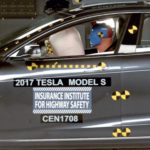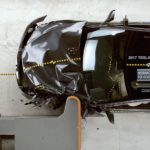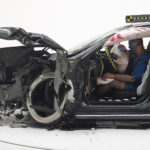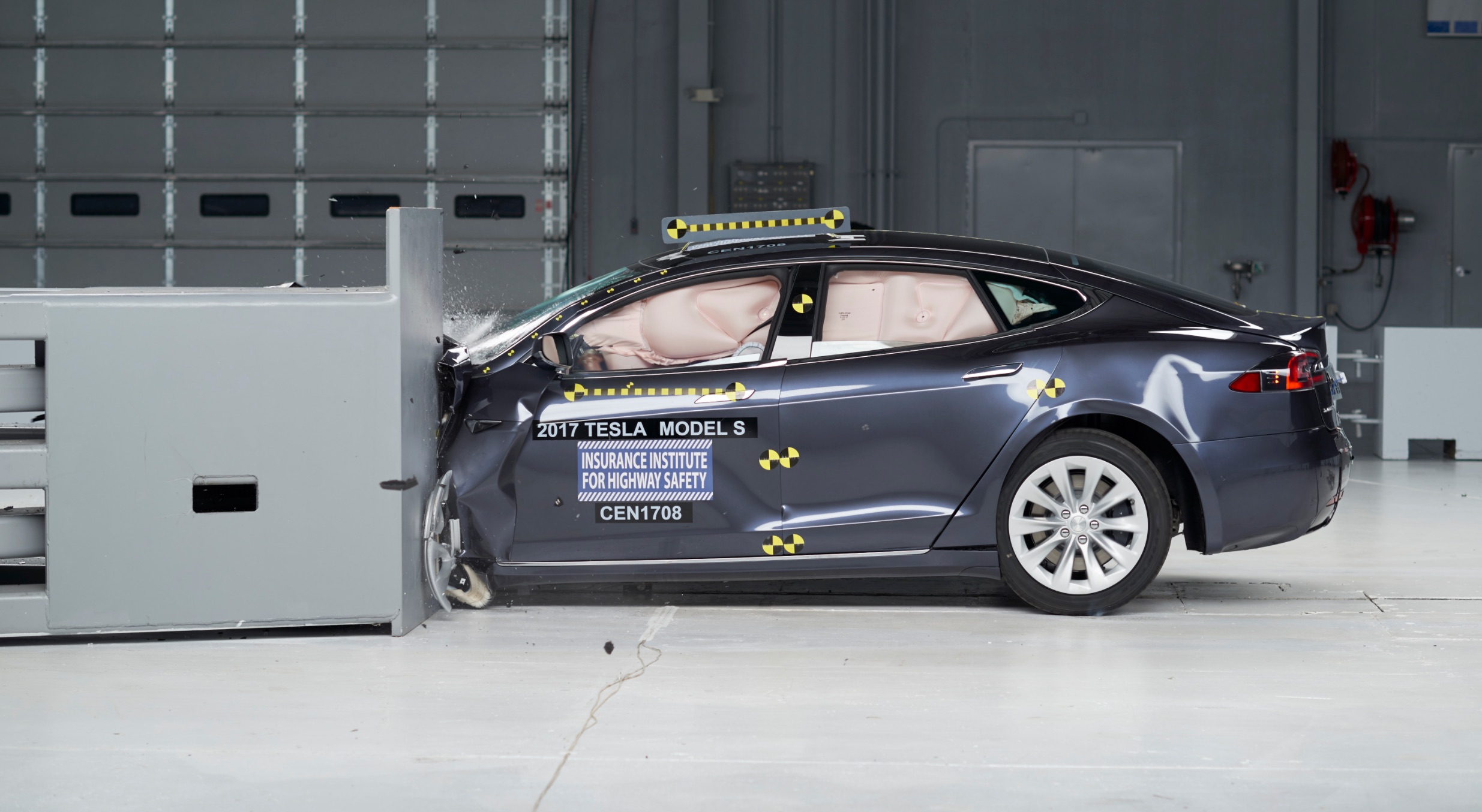
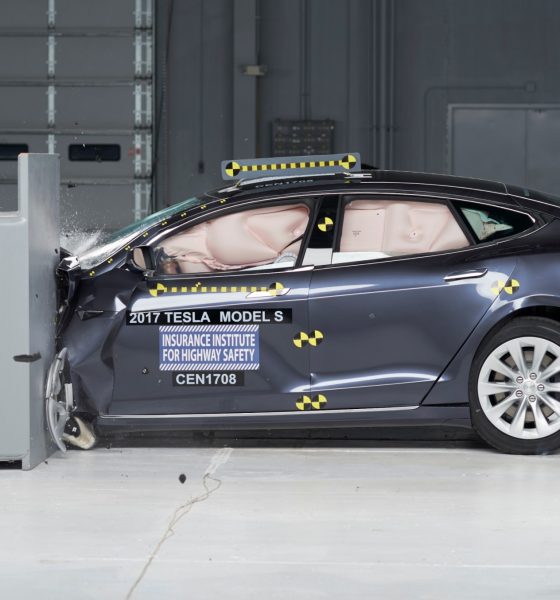
News
Tesla Model S misses top safety rating by Insurance Institute for Highway Safety
Tesla’s 2017 Model S has missed the Insurance Institute for Highway Safety’s (IIHS) top-safety pick+ rating, citing issues with the small overlap front test. Tesla had made changes to the vehicle in January to fix issues in this area, but the IIHS test results show otherwise.
“Tesla made changes to the safety belt in vehicles built after January with the intent of reducing the dummy’s forward movement,” IIHS said in a statement today. “However, when IIHS tested the modified Model S, the same problem occurred, and the rating didn’t change.”
The small overlap front test is meant to simulate crashes into trees, poles, and other vehicles. IIHS EVP & chief research officer David Zuby said that the small overlap front test still remains a “hurdle” for some vehicles, including vehicles with existing “stellar” ratings.
Tesla’s changes to the vehicle in January were largely focused on the seat belt, but inconsistent wheel movement in the test actually performed worse than the previous test vehicle. “Maximum intrusion increased from less than 2 inches to 11 inches in the lower part and to 5 inches at the instrument panel in the second test,” IIHS said in their statement.
Tesla responded to the report, saying that Model S received the highest rating in IIHS’s crash testing in every category except in the overlap front crash test, where it received the second highest rating available. “IIHS and dozens of other private industry groups around the world have methods and motivations that suit their own subjective purposes,” said a spokesperson from Tesla.
2017 Tesla Model S received an “acceptable” rating the IIHS on the small overlap front test (Photo: IIHS)
The test also damaged the front left portion on the battery pack, but the test vehicle didn’t contain battery cells in that area. The damage to the battery pack didn’t cause any changes to the rating.
“The greater deformation in the second test also resulted in damage to the left front corner of the battery case. The deformation was limited to an area that didn’t contain battery cells in the tested vehicle, so this damage didn’t affect the rating. Higher-performance variants of the Model S could have battery cells in this area, but, according to Tesla, they also have different structure. They haven’t been tested separately and aren’t covered by this rating.” reads the IIHS report.
IIHS tests also concluded that the Tesla Model S headlights earned a poor rating because they have yet to be rated for front crash prevention. The agency also noted that they were unable to test the vehicle’s automatic emergency braking system as Tesla only recently activated the feature via a software update.
Despite Model S’ top safety rating by the NHTSA, the person who oversaw the IIHS Model S crash test said, “If you’re looking for top-line safety, we believe there are other, better choices than the Model S.”
Vehicles winning the Top Safety Pick+ include the Lincoln Continental, Mercedes-Benz E-Class, and the Toyota Avalon. The Tesla Model S received the highest rating in every other category besides the small overlap front test. The Tesla Model X recently received a 5-star safety rating from the NHTSA.

News
Tesla starts showing how FSD will change lives in Europe
Local officials tested the system on narrow country roads and were impressed by FSD’s smooth, human-like driving, with some calling the service a game-changer for everyday life in areas that are far from urban centers.

Tesla has launched Europe’s first public shuttle service using Full Self-Driving (Supervised) in the rural Eifelkreis Bitburg-Prüm region of Germany, demonstrating how the technology can restore independence and mobility for people who struggle with limited transport options.
Local officials tested the system on narrow country roads and were impressed by FSD’s smooth, human-like driving, with some calling the service a game-changer for everyday life in areas that are far from urban centers.
Officials see real impact on rural residents
Arzfeld Mayor Johannes Kuhl and District Administrator Andreas Kruppert personally tested the Tesla shuttle service. This allowed them to see just how well FSD navigated winding lanes and rural roads confidently. Kruppert said, “Autonomous driving sounds like science fiction to many, but we simply see here that it works totally well in rural regions too.” Kuhl, for his part, also noted that FSD “feels like a very experienced driver.”
The pilot complements the area’s “Citizen Bus” program, which provides on-demand rides for elderly residents who can no longer drive themselves. Tesla Europe shared a video of a demonstration of the service, highlighting how FSD gives people their freedom back, even in places where public transport is not as prevalent.
What the Ministry for Economic Affairs and Transport says
Rhineland-Palatinate’s Minister Daniela Schmitt supported the project, praising the collaboration that made this “first of its kind in Europe” possible. As per the ministry, the rural rollout for the service shows FSD’s potential beyond major cities, and it delivers tangible benefits like grocery runs, doctor visits, and social connections for isolated residents.
“Reliable and flexible mobility is especially vital in rural areas. With the launch of a shuttle service using self-driving vehicles (FSD supervised) by Tesla in the Eifelkreis Bitburg-Prüm, an innovative pilot project is now getting underway that complements local community bus services. It is the first project of its kind in Europe.
“The result is a real gain for rural mobility: greater accessibility, more flexibility and tangible benefits for everyday life. A strong signal for innovation, cooperation and future-oriented mobility beyond urban centers,” the ministry wrote in a LinkedIn post.
News
Tesla China quietly posts Robotaxi-related job listing
Tesla China is currently seeking a Low Voltage Electrical Engineer to work on circuit board design for the company’s autonomous vehicles.

Tesla has posted a new job listing in Shanghai explicitly tied to its Robotaxi program, fueling speculation that the company is preparing to launch its dedicated autonomous ride-hailing service in China.
As noted in the listing, Tesla China is currently seeking a Low Voltage Electrical Engineer to work on circuit board design for the company’s autonomous vehicles.
Robotaxi-specific role
The listing, which was shared on social media platform X by industry watcher @tslaming, suggested that Tesla China is looking to fill the role urgently. The job listing itself specifically mentions that the person hired for the role will be working on the Low Voltage Hardware team, which would design the circuit boards that would serve as the nervous system of the Robotaxi.
Key tasks for the role, as indicated in the job listing, include collaboration with PCB layout, firmware, mechanical, program management, and validation teams, among other responsibilities. The role is based in Shanghai.
China Robotaxi launch
China represents a massive potential market for robotaxis, with its dense urban centers and supportive policies in select cities. Tesla has limited permission to roll out FSD in the country, though despite this, its vehicles have been hailed as among the best in the market when it comes to autonomous features. So far, at least, it appears that China supports Tesla’s FSD and Robotaxi rollout.
This was hinted at in November, when Tesla brought the Cybercab to the 8th China International Import Expo (CIIE) in Shanghai, marking the first time that the autonomous two-seater was brought to the Asia-Pacific region. The vehicle, despite not having a release date in China, received a significant amount of interest among the event’s attendees.
Elon Musk
Elon Musk and Tesla AI Director share insights after empty driver seat Robotaxi rides
The executives’ unoccupied tests hint at the rapid progress of Tesla’s unsupervised Robotaxi efforts.

Tesla CEO Elon Musk and AI Director Ashok Elluswamy celebrated Christmas Eve by sharing personal experiences with Robotaxi vehicles that had no safety monitor or occupant in the driver’s seat. Musk described the system’s “perfect driving” around Austin, while Elluswamy posted video from the back seat, calling it “an amazing experience.”
The executives’ unoccupied tests hint at the rapid progress of Tesla’s unsupervised Robotaxi efforts.
Elon and Ashok’s firsthand Robotaxi insights
Prior to Musk and the Tesla AI Director’s posts, sightings of unmanned Teslas navigating public roads were widely shared on social media. One such vehicle was spotted in Austin, Texas, which Elon Musk acknowleged by stating that “Testing is underway with no occupants in the car.”
Based on his Christmas Eve post, Musk seemed to have tested an unmanned Tesla himself. “A Tesla with no safety monitor in the car and me sitting in the passenger seat took me all around Austin on Sunday with perfect driving,” Musk wrote in his post.
Elluswamy responded with a 2-minute video showing himself in the rear of an unmanned Tesla. The video featured the vehicle’s empty front seats, as well as its smooth handling through real-world traffic. He captioned his video with the words, “It’s an amazing experience!”
Towards Unsupervised operations
During an xAI Hackathon earlier this month, Elon Musk mentioned that Tesla owed be removing Safety Monitors from its Robotaxis in Austin in just three weeks. “Unsupervised is pretty much solved at this point. So there will be Tesla Robotaxis operating in Austin with no one in them. Not even anyone in the passenger seat in about three weeks,” he said. Musk echoed similar estimates at the 2025 Annual Shareholder Meeting and the Q3 2025 earnings call.
Considering the insights that were posted Musk and Elluswamy, it does appear that Tesla is working hard towards operating its Robotaxis with no safety monitors. This is quite impressive considering that the service was launched just earlier this year.
